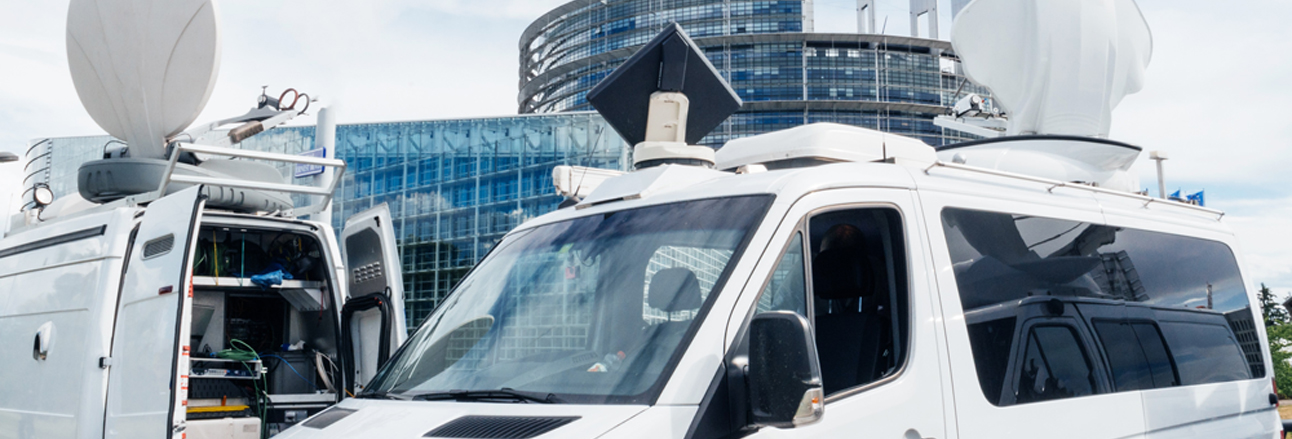Once again, we’d like to thank everyone that attended and has viewed on-demand our Boosting SNG via All-IP Networks webinar. We hope that you enjoyed the unique perspectives and insights from our guests and that we were able to highlight the benefits of going All-IP and the trends that are evident in the SNG market.
The digitization of the broadcast sector has seen the use of IP increase and, as a result, it is now overtaking more traditional methods of broadcasting. The market is fast evolving, and a simple contribution link is no longer sufficient for outside broadcasts. Today a mix of applications are used and access to the Internet, to file transfers, email and newsdesk apps are essential. Connectivity must allow for flexibility and must be operated anywhere. The webinar explored the transition to All-IP in the context of SNG and outside broadcasting and the entire event can be viewed here.
During the webinar, our panelists, Jonathan Higgins, Managing Director at Beaconseek (UK); Steve Bretherick, CEO at Telemedia (South Africa); Alex Pimentel, CEO of Casablanca Online (Brazil) and Chris Dredge, Managing Director at Pacific Live Media (Australia) offered their insight and knowledge on this evolution in SNG capabilities and how it is taking off in different regions around the world.
As promised, we have further responses to some of the questions we didn’t get time to answer. We hope you find them helpful. We’ve reached out to our panelists; our partners, Network Innovations and Dejero and our own experts to get the answers.
Could you elaborate more on cellular bonding and its applications?
John Stoltz, Network Innovations: Clients use devices to aggregate cellular data together from various cell providers to provide IP connectivity. These bonding systems offer better reliability and faster broadband speeds. In the broadcast world, companies like LiveU are leaders in this area for streaming live video as they balance the adaptive-bit-rate encoder with the dynamic bandwidth provided via multiple bonded SIM cards. Other verticals may only need ‘data in the field’ without live video applications. Public safety markets may use devices like Peplink to bonded cellular data together to run their first responder applications. Nearly all of these cellular-data bonders can use Satellite-IP services like MAVERICK to supplement or complement when cellular data either is unavailable or over-congested. NI offers our uLINK service bundle in conjunction with Satellite-IP services as failover for bonded-cellular services.
Kevin Fernandes, VP, Revenue, Broadcast, Dejero: For many organizations, staying connected is extremely important and often mission critical. Having only one connection path leaves organizations vulnerable to having insufficient bandwidth to carry out key tasks, or in the worst case, downtime.
Cellular bonding allows organizations to effectively, efficiently, and reliably leverage the combined capacity of their individual connections, even when they have different and variable bandwidth and latency—ultimately enabling important and valuable use cases.
- Broadcast and Media companies can transport video and data reliably from virtually anywhere, no matter how remote or mobile
- Public Safety organizations gain enhanced real-time situational awareness and response capabilities even when networks are stressed
- Transit and Transportation services can enable streamlined vehicle data transmission, even at high speeds and across large geographies
- Enterprises gain the ability to keep their branch locations and mobile workforce reliably connected, without relying on expensive dedicated links
IP over Ku-band satellites has a 600ms round trip time so what will it be with LEO satellites in comparison to the 40-50ms round trip for 4G?
John Stoltz, Network Innovations: In terms of round-trip speeds of LEO networks it should be fairly similar to cellular latency in the high double-digit range.
Kevin Fernandes, VP, Revenue, Broadcast, Dejero: LEO is an exciting technology that will likely improve satellite communications when it is available including reducing latency. However, we will need to test the performance of this new technology and how it will impact the use cases for our customers.
How do you deal with the latency difference between a terrestrial cellular path and a satellite IP path without having a connection that is very latent and not as suitable for two-way broadcasting often required in news?
Chris Dredge, Pacific Live Media: When using satellite IP as well as cellular, we set the overall latency to one that suits the longest path, that being the satellite path. Typically, an end to end latency of around 1.5 seconds is sufficient to aggregate both the Cellular and the satellite paths for the best result. 1.5 seconds is pretty normal for bonded cellular latencies, so this won’t appear all that different to the remote contributor.
IFB (Interruptible Foldaback) Audio is most affected in a satellite-only environment with the Audio on the return path delayed a little longer than it would be on Cellular alone. The total round trip would be approximately 3 seconds.
SES Europe, utilizing a Newtec modem, is currently offering a IP over Ku with an Occasional Use Hub. How do we manage the modem’s power, when its used in conjunction with offering a traditional DVB Broadcast uplink path?
Gert Copejans, ST Engineering iDirect: With the MxDMA return channel technology (which is the technology of choice for this kind of application), the power of the (different) carriers of the connected modems is managed automatically. The system is designed such that as more power is required (due to fading, extra traffic etc.), distortion as a precedence of saturation is constantly measured. This is then kept under a predefined level so as not to disturb the uplink path.
Want to learn more?
View the webinar in its entirety at the ST Engineering iDirect Content Hub.
The new Boosting SNG via All-IP Networks whitepaper can also be viewed here.
